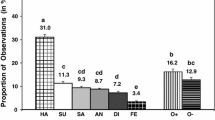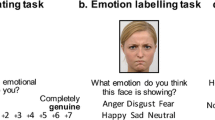Abstract
This study investigated the effect of the physical presence of a friend or of a stranger on facial expressiveness. Pairs of friends and pairs of strangers (all women) were unobtrusively videotaped while they viewed together a number of emotional stimulus slides, and rated their individual emotional responses to them. Judges subsequently attempted to identify from the videotapes the emotions reported by each sender subject. Generally, expressions were more readily identified for women videotaped with friends than for those recorded with strangers. These results support the suggestion that the degree to which emotions are expressed depends on the role of an accompanying person. Altemative interpretations of this view are discussed.
Similar content being viewed by others
References
Andrus, T.D. (1946). A study of laugh patterns in the theatre.Speech Monographs, 13, 114.
Brightman, V., Segal, A., Werther, P., & Steiner, J. (1975). Ethologic study of facial expressions in response to taste stimuli.Journal of Dental Research, 54, L141.
Brightman, V., Segal, A., Werther, P., & Steiner, J. (1977). Facial expression and hedonic response to taste stimuli.Journal of Dental Research, 56, B161.
Buck, R. (1984).The communication of emotion. New York: Guilford.
Buck, R.W., Savin, V.J., Miller, R.E., & Caul, W.F. (1972). Communication of affect through facial expressions in humans.Journal of Personality and Social Psychology, 23, 362–371.
Chapman, A.J. (1973). Social facilitation of laughter in children.Journal of Experimental Social Psychology, 9, 528–541.
Ekman, P. (1977). Biological and cultural contributions to body and facial movement. In J. Blacking (Eds.),The anthropology of the body (pp. 34–84). London: Academic Press.
Ekman, P. (1989). The argument and evidence about universals in facial expressions of emotion. In H.L. Wagner & A.S.R. Manstead (Eds.),Handbook of social psychophysiology (pp. 143–164). Chichester/New York: Wiley.
Ekman, P., & Friesen, W.V. (1969). The repertoire of nonverbal behavior: categories, origins, usage, and coding.Semiotica, 1, 49–98.
Ekman, P., & Friesen, W.V. (1978).The facial action coding system Palo Alto, CA: Consulting Psychologists Press.
Fridlund, A.J. (1991). Sociality of solitary smiling: potentiation by an implicit audience.Journal of Personality and Social Psychology, 60, 229–240. (b).
Fridlund, A.J. (1991). Evolution and facial action in reflex, social motive, and paralanguage.Biological Psychology, 32, 1–96. (a).
Fridlund, A.J., Sabini, J.P., Hedlund, L.E., Schaut, J.A., Shenker, J.I., & Knauer, M.J. (1990). Audience effects on solitary faces during imagery: Displaying to the people in your head.Journal of Nonverbal Behavior, 14, 113–137.
Goffman, E. (1959).The presentation of self in everyday life New York: Anchor.
Guerin, B. (1986). Mere presence effects in humans: A review.Journal of Experimental Social Psychology, 22, 38–77.
Izard, C.E. (1977).Human emotions. New York: Plenum.
Kilbride, J.E., & Yarczower, M. (1980). Recognition and imitation of facial expressions: A cross-cultural comparison between Zambia and the United States.Journal of Cross-Cultural Psychology, 11, 281–296.
Kleck, R.E., Vaughan, R.C., Cartwright-Smith, J., Vaughan, K.B., Colby, C.Z., & Lanzetta, J. T. (1976). Effects of being observed on expressive, subjective and physiological responses to pain stimuli.Journal of Personality and Social Psychology, 34, 1211–1218.
Kraut, R.E. (1982). Social presence, facial feedback, and emotion.Journal of Personality and Social Psychology, 42, 853–863.
Oster, H., Daily, L., & Goldenthal, P. (1989). Processing facial affect. In A.W. Young & H.D. Ellis (Eds.),Handbook of research on face processing (pp. 107–161). Amsterdam: Elsevier Science Publishers.
Schlenker, B.R. (1980).Impression management. Monterey, CA: Brooks-Cole.
Wagner, H.L. (1990). The spontaneous facial expression of differential positive and negative emotions.Motivation and Emotion, 14, 27–43.
Yarczower, M., & Daruns, L. (1982). Social inhibition of spontaneous facial expressions in children.Journal of Personality and Social Psychology, 43, 831–837.
Yarczower, M., Kilbride, J.E., & Hill, L.A. (1979). Imitation and inhibition of facial expressions.Developmental Psychology, 15, 453–454.
Author information
Authors and Affiliations
Additional information
We thank Alan Fridlund and an anonymous reviewer for comments on a previous version of this paper.
Rights and permissions
About this article
Cite this article
Wagner, H.L., Smith, J. Facial expression in the presence of friends and strangers. J Nonverbal Behav 15, 201–214 (1991). https://doi.org/10.1007/BF00986922
Issue Date:
DOI: https://doi.org/10.1007/BF00986922




